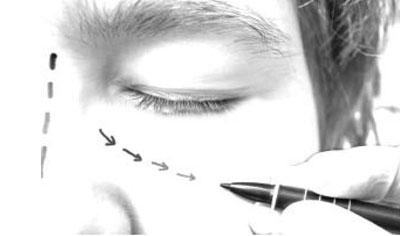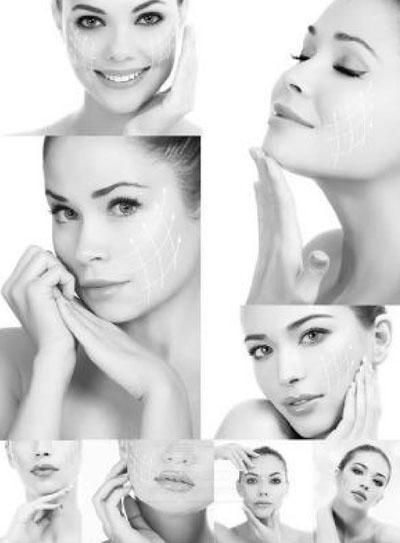池茹:来自整容外科前线的报道



Photographer Ji Yeos shots of women in the aftermath of cosmetic surgery have transfixed online audiences. But has her work changed her teenage wish to go under the knife?
The photographer Ji Yeo had two dreams as an adolescent. One was to attend a prestigious college. The other was to have a full body transformation, top to toe, through cosmetic surgery. She spent her school years moving between the U.S. and South Korea, and when she had achieved her first ambition, starting university in Seoul, she began pursuing her second.
In her late teens she saw several cosmetic surgeons, more than 12 in all. Now 29, she says of that time: “I didnt like myself at all. I had very low self-esteem. I even hated my toenails! I didnt like my hair. I didnt like my eyebrows.”But the consultations failed to clear up her concerns about surgery. “The more I did,” she says, “the more I questioned plastic surgery, because none of the doctors clearly explained how the surgeries would go, or the possible side effects. Not knowing every detail, I felt I just couldnt do it…I had wanted plastic surgery my entire life, but I realised maybe something outside of me was almost forcing me to want it.”
To test this theory, she stopped the consultations, and embarked on her Beauty Recovery Room project. She contacted women through an online cosmetic surgery forum in South Korea, and asked whether theyd agree to have their picture taken in the days after surgery, when they were still bandaged. In return, in some cases, she helped look after them. Around 10 women said yes, and the results are extraordinary. The images show women at their most vulnerable: bandaged, bruised and scarred, in some cases with weeping wounds. In a culture where women are heavily criticised for looking old, out of shape or tired—but also for any obvious signs of cosmetic surgery—the photos show a part of the process thats rarely seen, a moment when a woman is very clearly, unequivocally, a surgical subject.
The photos have exerted such a fascination, that they keep on circulating—both online, where they were most recently covered by Wired magazine—and on the gallery circuit. Ji was shortlisted for the 2013 Taylor Wessing photographic portrait prize, which led to an image of a woman in surgical stockings and head bandage appearing in the National Portrait Gallery in London. She has been exhibited in Brighton, is currently on show at three galleries in the U.S., and has just been part of a two-person show in South Korea.
In her series Somewhere on the Path, I See You, she took portraits of women in an eating-disorder support group, and is currently at work on a project depicting cosmetic-surgery facilities in South Korea. “Plastic surgery clinics are huge here,” she says. “Its almost a hospital, not just a clinic. Its a 14-floor building, with entertainment rooms, everything…So Im taking photos of these interiors.”
In 2010, she dressed in a skin-coloured leotard and went to the bustling Brooklyn flea market alongside a sign saying, “I want to be perfect. Draw on me. Where should I get plastic surgery?” The performance was initially daunting, she says. “I was really nervous at the idea of putting myself into vulnerable situations, and I dont even like it when people stare at me on the street.” She found, in some cases, that men were looking very closely at specific parts of her body. “But during the performance I got really comfortable that people were coming up to me and saying they were surprised at the idea of me getting plastic surgeries.” They scrawled on the leotard and on her skin, “You are beautiful as you are,”“You already are perfect”; and “Not here” along her thighs. “It felt great,” she says. “It doesnt mean that I overcame all my fears or vulnerability, but it helped a little bit.”
Perhaps surprisingly, taking the photos for Beauty Recovery Room made her more accepting of the idea of plastic surgery. “I was really influenced by talking and interacting with the women—at the beginning I had a huge fear about surgery, about lying on the bed, but I dont feel any fear now. I became one of them, I guess. I feel like its very casual, its not that big a deal, and Im more fond of plastic surgery these days.”
South Korea is estimated to be the worlds largest market for cosmetic surgery, with a 2009 survey suggesting one in five women aged 19 to 49 in Seoul have had a procedure. Ji was surprised, at first, by the attitudes she encountered from her subjects, but came to understand them. “One woman was going to get a breast enlargement, and she got a bank loan for it, because she didnt have the money.” When an examination revealed a problem with one of her breasts, Ji assumed that any surgery was off. “But instead of getting a breast enlargement, she got a nose job and chin implant. So it wasnt about getting a breast enlargement, it was about getting plastic surgery, and enhancing their appearance. For most of them, the attitude was very casual. There was no fear, more excitement…Maybe its not true, but I felt even with the bandages and the pain they were more confident.”
Virginia Blum, a U.S. professor and author of the book Flesh Wounds: The Culture of Cosmetic Surgery has said that cosmetic surgery can be addictive, “because people potentially experience that swell of self-esteem, and then they want to have that experience again. I would argue that thats because its located in the realm of consumption. Youve consumed this body transformation, and have a really great feeling, and want to sustain it. I also argue, either way, that once youre in it, youre in it. You either have a bad cosmetic surgery result, and have to redo yourself, because the result was insufficient—or the result was really great, and you want to reproduce that intoxicated feeling.”
One of the women Ji photographed had had more than 16 surgeries in the space of six months. “Women continue to experience their body as more mutable,” Blum says, because, “women are raised around a fashion-magazine culture in which we realise we can work on these different body parts, so we divide and conquer. Plastic surgery approaches the body in much the same way women are trained from girlhood to approach their bodies. And male bodies are not quite as available to that divide-and-conquer model, although I think they are becoming increasingly so.”
The power and discomfort of Jis images arises, at least in part, through her own ambivalence. She says the reaction to them has differed according to culture. “Audiences in the U.S. and Europe seem to be more surprised by the images than a Korean audience. Koreans usually see the photos and instantly try to figure out what they had done—so its a guessing game. ‘Oh, shes done eyes and nose or ‘Shes done liposuction”. Living between the two cultures, Ji says she still has a desire to get plastic surgery—she might one day have a facelift—“but then theres another me saying,‘no, youre beautiful as you are. Theyre always fighting.” Can she live happily with that? “I think Ive got used to it.”
攝影师池茹在青少年时期拥有两个梦想。第一个梦想是入读名牌大学。第二个梦想是通过整容手术进行从头到脚彻底的身体改造。在求学时期,她一直往返于美国和韩国之间,当她实现了自己的第一个梦想,在首尔入读大学后,她开始追求自己的第二个梦想。
池茹十八九岁的时候看过一些美容整形外科医师,算起来不止12位。她如今29岁,她说当时的自己:“我一点都不喜欢自己,非常自卑。我甚至连自己的脚趾甲都讨厌!我也不喜欢自己的头发,不喜欢自己的眉毛。”但是那些咨询并没有消除她心中对手术的疑虑。“我越是咨询,”她说道,“便对整容手术愈加怀疑,因为没有一位医生能够清楚地解释手术结果如何,或是可能的副作用。无法了解每一个细节,我觉得自己做不到……我一直都想要进行整容手术,但是我意识到可能是外界的力量迫使自己急切地想要接受整容手术。
为了证实这个推测,她停止了手术咨询,并开始专注于自己的“美丽恢复室”的摄影项目。她通过韩国一个整形手术网络论坛联系到一些女性,并询问她们是否愿意在手术后的恢复期接受拍摄,恢复期间她们还缠着绷带。作为回报,在某些情况下,她帮忙照看她们。大约有10名女性同意了拍摄,效果十分令人震惊。照片拍摄的是这些女性最为脆弱的时期:缠着绷带、鼻青脸肿、伤痕累累,有些人的伤口还在渗液。我们身处这样一个文化中:女性不仅会因显老、身材走样或面容疲倦而被狠批——就是身上有任何明显的整容手术迹象也会备受苛责——这些照片呈现出整容手术罕见的一部分过程,这时候的女人明确无疑是一个“被开刀”的对象。
这些照片在网上引起了巨大的关注,被不断转载,最近在网上被《联线》杂志刊登,另外也在画廊巡回展出。池茹入围了2013年的“泰勒·韦辛肖像摄影奖”,由此,身着手术长袜和头绑绷带的女人肖像出现在伦敦的国家肖像美术馆里。这幅女人肖像曾在布莱顿展出,目前正在美国的三个美术馆展出,也在不久前在韩国一场二人艺展中展出。
在池茹的摄影系列《路途中与你相遇》中,她为“饮食紊乱症互助组”中的女子拍照。她目前正着手于一个展现韩国整形美容设备的项目。“在韩国,整形外科诊所都很大”她说道。“几乎是医院的规模,而不仅仅是家诊所。这是一栋14层的建筑,带康乐室,应有尽有……因此我拍摄下它们的内部结构。”
2010年,池茹曾穿着肉色紧身连衣裤,站在熙熙攘攘的布鲁克林跳蚤市场中,旁边放着一个标牌,写着,“我想要更完美,请在我身上画出来。我哪里需要做整形手术改进?”这个任务最初让我胆怯,她说道。“一想到要把自己置于脆弱的境况中,我就很不安,我也不喜欢大街上的人都盯着我看。”她发现,有时候,男性们会非常关注她身体的某些特定部位。“但是期间也有人走过来和我说他们非常惊讶我需要做整形手术,这让我感到欣慰。”他们在池茹的紧身衣和皮肤上涂画,“你本来就很美丽,”“你已经很完美了”;还有在她的大腿上写下“绝对不是这里”。“那感觉很棒,”她说道。“这并不意味着我克服了所有的恐惧和脆弱,但是确实有所帮助。”
也许有点意外,但“美丽恢复室”的摄影项目使池茹更接受了整形这种想法。“与那些女性交谈和互动,确实使我受到了影响——最初我对于整容手术和整天躺在床上有莫大的恐惧,但现在不会。我想我已成为她们中的一员。我感觉那是很随意的事情,并没什么大不了,我现在更加喜欢整形手术了。”
韩国被认为是世界上最大的整形手术市场,2009年的调查显示,在首尔,19-49岁的女性中,有五分之一的人接受过整形手术。最初池茹对拍摄对象的态度感到非常惊讶,但后来她开始理解她们了。“一位女士要去隆胸,因为她自己无法支付手术费,就只能贷款来支付这笔费用。”后来她通过检查发现自己一边乳房有問题时,池茹以为她会打消整形的念头。“但是她只是没做隆胸手术,换了做隆鼻和下巴植入手术。所以,重点不在于隆胸还是别的手术,而是她们就是想整容,想美化外表。她们中大部分人的态度都十分随意。没有恐惧,更多的是兴奋……或许这不是真的,但是我感觉到,即使缠着绷带,忍受着剧痛,她们看起来自信多了。”
弗吉尼亚·布卢姆,一位美国教授兼《肉体创伤:整容手术的文化》一书作者曾宣称,整容手术会使人上瘾,“因为经历过自尊心的膨胀,他们就想要再次经历同样的体验。我认为这属于消费领域的议题。你消费了这项身体改造服务之后,感觉非常棒,并想要维持改变后的身体。我也认为,无论以何种方式,你一旦接触,便深陷其中。你或是得到一个失败的整形手术结果,而不得不重新接受手术,因为结果不理想——或者结果太好,你想要再次享受那份美妙醉人的感觉。”
池茹拍摄的其中一位女性在半年中接受了超过16次的整容手术。“女性们想要持续体验身体可变的感觉,”布卢姆说道,因为,“女性们成长于一个时尚杂志文化中,我们意识到可以改造身体不同的部位,所以我们分而治之。整容手术处理身体的方式和女性们从小对待自己身体的方式几乎是一致的。而男性们的身体则不适用于分而治之的模式,虽然我觉得他们也逐渐变得适用这种模式。”
池茹所摄肖像带来的震撼和冲击,多少从她自身的矛盾纠结中透现。她说对于不同的文化,人们对肖像的反应各有不同。“美国人和欧洲人看见这些肖像时的反应比韩国人更为震惊。韩国人一看到这些肖像就立即试图断定肖像中的人都做过什么手术——因此这是个猜谜游戏。‘噢,她的眼睛和鼻子都整过或者‘她做过抽脂手术”。生活在两种文化之间,池茹说自己还是有整容的欲望——她可能有一天会接受拉皮手术——“但是这时候会有另一个我说道,‘不,你本来就很美。两种想法之间总是在作斗争。”她能够就这样快乐地生活下去吗?“我想我已经习惯了。”

